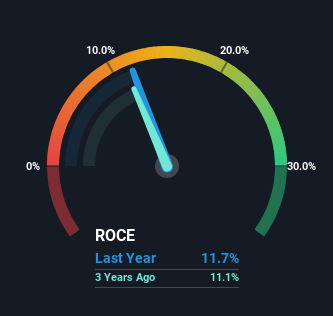Returns At DaVita (NYSE:DVA) Appear To Be Weighed Down
What trends should we look for it we want to identify stocks that can multiply in value over the long term? One common approach is to try and find a company with returns on capital employed (ROCE) that are increasing, in conjunction with a growing amount of capital employed. Ultimately, this demonstrates that it's a business that is reinvesting profits at increasing rates of return. However, after briefly looking over the numbers, we don't think DaVita (NYSE:DVA) has the makings of a multi-bagger going forward, but let's have a look at why that may be.
Return On Capital Employed (ROCE): What Is It?
For those that aren't sure what ROCE is, it measures the amount of pre-tax profits a company can generate from the capital employed in its business. Analysts use this formula to calculate it for DaVita:
Return on Capital Employed = Earnings Before Interest and Tax (EBIT) ÷ (Total Assets - Current Liabilities)
0.12 = US$1.7b ÷ (US$17b - US$2.6b) (Based on the trailing twelve months to March 2024).
So, DaVita has an ROCE of 12%. That's a relatively normal return on capital, and it's around the 11% generated by the Healthcare industry.
Check out our latest analysis for DaVita
In the above chart we have measured DaVita's prior ROCE against its prior performance, but the future is arguably more important. If you'd like, you can check out the forecasts from the analysts covering DaVita for free.
So How Is DaVita's ROCE Trending?
There hasn't been much to report for DaVita's returns and its level of capital employed because both metrics have been steady for the past five years. This tells us the company isn't reinvesting in itself, so it's plausible that it's past the growth phase. So don't be surprised if DaVita doesn't end up being a multi-bagger in a few years time.
On a side note, DaVita has done well to reduce current liabilities to 15% of total assets over the last five years. Effectively suppliers now fund less of the business, which can lower some elements of risk.
In Conclusion...
In a nutshell, DaVita has been trudging along with the same returns from the same amount of capital over the last five years. Yet to long term shareholders the stock has gifted them an incredible 150% return in the last five years, so the market appears to be rosy about its future. But if the trajectory of these underlying trends continue, we think the likelihood of it being a multi-bagger from here isn't high.
One more thing: We've identified 2 warning signs with DaVita (at least 1 which makes us a bit uncomfortable) , and understanding these would certainly be useful.
If you want to search for solid companies with great earnings, check out this free list of companies with good balance sheets and impressive returns on equity.
Have feedback on this article? Concerned about the content? Get in touch with us directly. Alternatively, email editorial-team (at) simplywallst.com.
This article by Simply Wall St is general in nature. We provide commentary based on historical data and analyst forecasts only using an unbiased methodology and our articles are not intended to be financial advice. It does not constitute a recommendation to buy or sell any stock, and does not take account of your objectives, or your financial situation. We aim to bring you long-term focused analysis driven by fundamental data. Note that our analysis may not factor in the latest price-sensitive company announcements or qualitative material. Simply Wall St has no position in any stocks mentioned.
Have feedback on this article? Concerned about the content? Get in touch with us directly. Alternatively, email editorial-team@simplywallst.com

 Yahoo Finance
Yahoo Finance 
